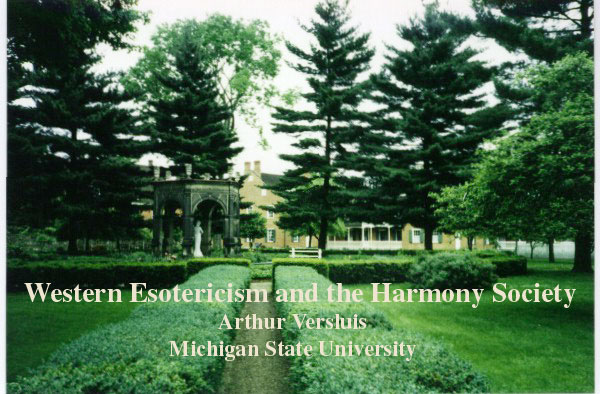 |
 |
 |
|
|
|
|
Studies in American Esotericism
Western Esotericism and The Harmony Society
Arthur Versluis
Michigan State University
Without a doubt, one of the most remarkable utopian communities in American history was that of the Harmonists, founded and led by Johann Georg Rapp (1757-1847) and his adopted son, Frederick Rapp (1775-1834). The Harmony Society is to this day most well known for its worldly success, which by any standard was phenomenal. In the mid-nineteenth century, the Harmony Society's per capita income was ten times that of the average American, and the Society was well known for its huge agricultural projects, its factories, its ingenious inventions, and its wealth. In this respect alone, the Harmony Society was an American marvel. This outward success has been well documented by the Herculean efforts of Karl Arndt, who singlehandedly compiled, edited, and published massive volumes of original materials from the Harmonists.[1] But what was it that motivated the Harmonists? What drew this society together and inspired its members? When we turn our attention from outward success to inward motivation, we find that the center of this remarkable utopian society was in fact Western esotericism - in particular, Christian theosophy and alchemy.
George Rapp (1757-1847)
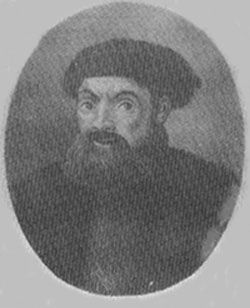 |
|
|
|
|
|
The Harmonist Church in Economy, Pennsylvania, across the street from the main Rapp house.
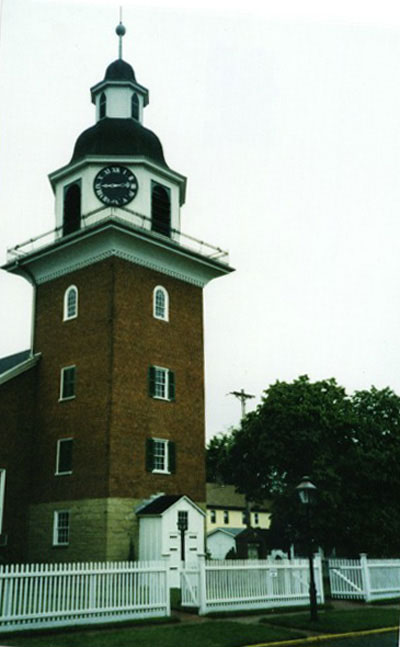 |
 |
 |
 |
|
21
|
|
|
The history of the Harmony Society is documented extensively in the series of large volumes edited by Karl Arndt, and there we find overwhelming evidence of how important Christian esotericism was for the Rapps. But we should begin by considering the ambience in Württemberg, Germany, from which the Harmonists emigrated in 1803-1804. To say that a rigid church orthodoxy reigned in Rapp's day is an understatement. If the Lutheran church to which Jacob Böhme (1575-1624) belonged was hostile to his mysticism in the early seventeenth century, even more hostile to mysticism was the Lutheran ambience in which Rapp lived a century and a half later. The records of the Iptingen Kirchenkonvent (Church Council), collected and published by Arndt, show the kind of conditions that finally drove the Harmonists to leave Germany and come to Pennsylvania.
In the late eighteenth century, the Lutheran church dominated life in Württemberg: secular and religious governments were closely intertwined, and those who separated from the official church were treated with great suspicion. The first official church reports that there were unruly Separatists in Iptingen appear in 1785, [2] and by 1787, the Civil and Religious Affairs Office (Gemeinschaftliche Oberamt) of Iptingen had sent a "Church Patrol" group to visit Rapp's small group, who were reading the works of Jacob Böhme, and Schütz's Die Güldene Rose. . . von der Wiederbringung Aller Dinge [The Golden Rose . . . on the Restoration of All Things].[3] 
The title page from The Golden Rose
|
|
|
|
|
 |
 |
 |
|
22
|
|
|
Such works marked Rapp's group as Schwärmerey, or "enthusiasts," but what undoubtedly made this group even more suspect was their adamant insistence that theirs was authentic spirituality, while that of the official church was nothing more than "Babel," or hollow outward conformity.
There may well have been a degree of self-righteousness in the Rapp circle, but the term "Babel" itself, like the majority of the Harmonist beliefs, derived from the works of Jacob Böhme.
Böhme, as I have detailed elsewhere, in such books as Theosophia (1994) and Wisdom's Children (1999), wrote numerous books detailing his complex and often arcane cosmology, but at the center of Böhme's appeal was his insistence on the primacy of the individual's direct spiritual awakening. Such spiritual awakening came under the guidance of divine Wisdom, or Sophia, and it is clear that the Rapp circle in Germany was familiar with the major German sources of Sophianic spirituality inspired by the works of Böhme, including the writings of Gottfried Arnold (1666-1714), arguably the most important scholar among the theosophers.[4] 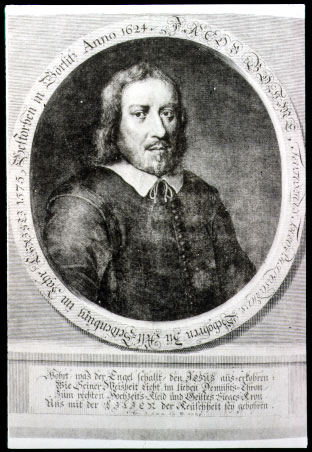
A portrait of Jacob Böhme
|
|
|
|
|
 |
 |
 |
|
23
|
|
|
Arnold's most important books were published in 1699/1700, and include his Unparteiische Kirchen- und Ketzer-historie, (4 vols.) and Das Geheimniss der Göttliche Sophia (1700).
Thus it is not surprising that Rapp while still in Germany wrote a pastoral letter on the theme of Solomon and his one thousand wives, which Rapp related to the millennial reign of Christ that was fast approaching. In this letter, Rapp refers to the "heavenly Sophia," but as Arndt points out, Rapp did not want to confide all that he thought on this subject to paper. Along with this letter, Arndt printed an anonymous Harmonist poem or hymn celebrating a spiritual erotic relationship with the heavenly Sophia. The poem is indeed fairly erotic in language, as it begins
Komm Tauben Gatte reinste Lust komm unser Bette blühet
weil du mir reichst der Weißheit Brust, da mein Mund Nahrung siehet,
du lockst mich wie ein lieblich Reh,
daß ich nur deiner Spuhr nachgeh
wie dein Ma[n]gnet mich ziehet.[5]
Come, spouse-dove of purest delight, come blossom in our bed
For you bestow to me Wisdom's breast, where my mouth takes [sees] sustenance,
You entice me like a lovely roe,
So that I go after only your trace,
As your magnet draws me.
Such spiritual eroticism was naturally subject to misinterpretation and was likely to incite even further suspicion among the authorities, so it is little wonder that Rapp and his circle were somewhat circumspect about their Sophianic spirituality, a circumspection |
|
|
|
|
 |
 |
 |
|
24
|
|
|
that they continued when they came to the United States.
An interesting connection from this same period in Germany has to do with the poet Justinus Kerner, who in his Das Bilderbuch aus meiner Knobenzeit (1786-1804) (Braunschweig, 1849), a book of recollections, recalled Rapp's visits to his father, the Oberamtmann at Maulbronn.[6] Kerner's father had shielded Rapp from prosecution by the authorities, and Kerner well remembered Rapp and his long black beard. This is particularly interesting because in 1829, Kerner published Die Seherin von Prevorst [The Seeress of Prevorst] , a remarkable book about Kerner's relationship with a young woman reputed to have visionary and healing powers.[7] This book made quite an impression among the Harmonists in 1829, who saw it as confirmation of the approaching millennium and of their own theosophy. A copy of the original publication is in the library collection at Old Economy, Pennsylvania, and bears George Rapp's own signature.
The Seeress of Prevorst, Friederike Hauffe née Wanner (1801-1829), subject of Kerner's book, created this image, using her own peculiar script. Entitled "Life-circle," it reveals a numero-astrological pattern of life events, and insofar as it exemplifies the prophetic nature of the seeress's vision and the possible coming of the millennium, this image and the book by Kerner from which it came, was certainly of interest to Georg Rapp and his group.
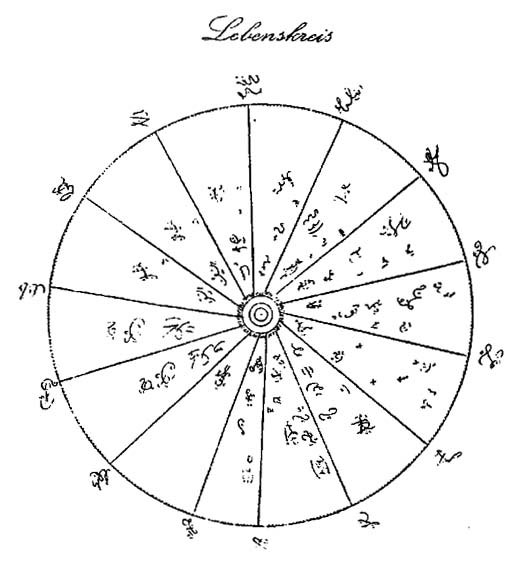 |
Of course, not everyone was as sympathetic to the Rapp circle as Kerner and his father, and by 1803, Rapp and his community were longing to leave Württemberg and its Church Police, and head to North America. |
|
|
|
|
 |
 |
 |
|
25
|
|
|
In October of 1803, Rapp and his son Johann, a local surveyor in Germany, arrived in Philadelphia, and eventually purchased 3000 acres of land in Butler County, Pennsylvania. On July 4, 1804, the ship Aurora brought nearly three hundred immigrants to Baltimore, and in September, another group of two hundred sixty-nine arrived at Philadelphia. The ship's name, Aurora , was also the name of Böhme's first book, seen as an auspicious coincidence. Rapp, eighty of these new settlers, his son John, and Frederick Reichert (shortly adopted by Rapp) began to settle the land in Butler County. On 15 February, 1805, they formally organized the Harmony Society, and placed all their goods in common.
The Harmony Society was extraordinarily successful, not least because of the organizing and negotiating powers of Frederick Rapp. By 1810, the Harmonists numbered nearly seven hundred; and their village included one hundred thirty houses, a church, a hotel, a school, a mill, a brewery and distillery, barns, storehouses, factory buildings, and a tannery. By 1814, the Society was farming some 3000 acres of land, with 3000 sheep and 600 cattle. But with all this worldly success, the group did maintain its Sophianic spirituality, as can be seen in a well-known image carved at the time by Frederick Rapp above a wine-cellar, a head with wings.
.
This image - the wingéd head - is traditionally a Christian representation of an angel, but is popularly held in this case to represent the Virgin Sophia
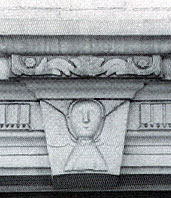
|
|
|
|
|
|
 |
 |
 |
|
26
|
|
|
In 1814, the society decided to move to a new location in Indiana, and their Pennsylvania holdings, now comprising 7000 acres and many buildings, were sold. By 1815, the entire community had moved to Indiana, to a 25,000 acre location along the Wabash River. They built a massive church in the form of a Maltese cross, with twenty-eight wooden pillars of walnut and cherry, six feet in circumference. Above the church entrance was a stone slab showing a golden rose, and an inscription from Micah 4:8: "Unto thee shall come the golden rose, the first dominion," that is believed to have been carved by Frederick Rapp himself, and that reveals the Rosicrucian and theosophic millennialism that the Rapps brought with them from Germany. The Indiana community became even more successful in selling its goods throughout the Midwest, but by 1824, the Society decided to move again, to its last home at Economy, Pennsylvania.
Here, by 1830, the Society had become the most economically successful communal group in American history. Indeed, they had actually constructed three small cities; and by this time their third was for the most part complete, including a church, a great house, a music hall, numerous houses, factories, warehouses, and working farms. |
|
|
|
|
A main street in Economy, [Ambridge] Pennsylvania. Note the drainage system along the street.
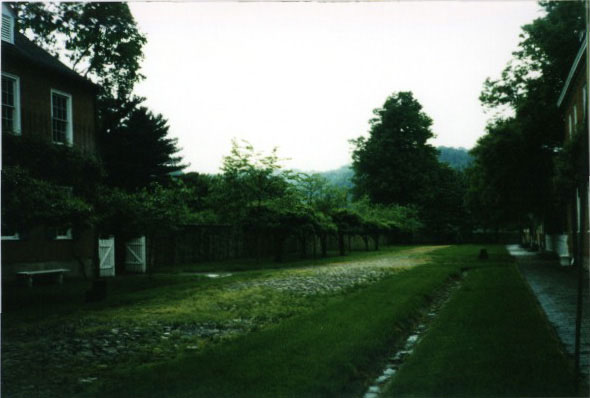 |
 |
 |
 |
|
27
|
|
|
The Harmonists were also quite ingenious in these practical matters, constructing behind the great house a greenhouse on moveable tracks, so it could be attached to the house in late winter and early spring, but pulled away in summer. They also constructed city drainage and steam heating systems that were quite innovative, including a community washinghouse heated by steam.
As might be imagined, this remarkable worldly success implied conflict with the esoteric spiritual aims of Rapp and his circle. At the same time, we should recognize that the Rosicrucian-theosophic millennialist ambience from which the Harmonist community emerged entailed the union of earthly and spiritual aims in the coming millennium, or golden age. It is true that the Rapps' circle in Germany despised the spiritus mundi or worldly spirit that governed both civil and religious life in the Old World; but it is also true that they saw the Old World as doomed, and America as the scene of a new golden age in which spiritual and earthly happiness would both be attained.
Albrecht Dürer's "Woman Clothed With the Sun," illustrating the Revelation of St. John, a central text for Christian esotericism generally,but especially so for millennialists like the Rapps.
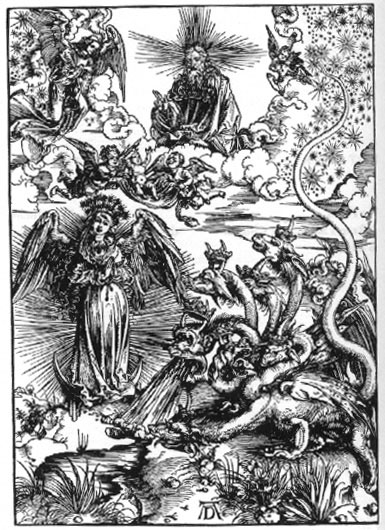 |
|
|
|
|
|
 |
 |
 |
|
28
|
|
|
This millennial expectation we can see in the following remarks of George Rapp himself, in the only book ever published by him, Thoughts on the Destiny of Man, (Harmony, Indiana: 1824, 94-96):
There is engrafted in our nature a solicitude for an advancement, to a far more exalted destiny, than can possibly be attained in this transitory world. The consequence is, our faculties can never be confined, or cease their operation, but, by their daily exercise, they are continually pressing forward to the point of their destined perfection.
How many great and conducible means have we in our power, for the restoration of the golden age! But correct feelings and strong incitements are yet to be awakened in the breasts of many, before that object can be accomplished. Perhaps it is necessary, that many and serious wants should urge men forward to its attainment, because, when a person stands in need of nothing, he has no stimulus for the acquirement of any thing.
Every exertion and difficulty, which are properly applied, are precious treasures, for the welfare of the human race. The earlier these correct principles can be impressed upon the human mind, and the sooner regular and virtuous habits can be formed, the more certain and the more permanent, will necessarily be their happy consequences.
It follows, that the proper education of Youth, is of the greatest importance to the prosperity of any plan, for the melioration of mankind. That kind of learning, and those fashionable accomplishments, which are useless and only calculated for show, should be entirely abolished, and in their stead, those true principles and habits of life should be established & confirmed, which most strongly tend to unite the hearts, minds, & fortunes of the rising generation, & arouse their sleeping faculties, for the performance of all that is truly good and great. It is ardently hoped and believed that this sublime, predestinated system of Brotherly Union & Social Harmony, will ere long be universally established, for the restora- |
|
|
|
|
 |
 |
 |
|
29
|
|
|
tion of the golden age, the dignity of the human character, and the happiness of man.
To read more of Thoughts on the Destiny of Man, click here.
There is, actually, relatively little trace of all of Rapp's esoteric studies in what we read here, the rousing conclusion of his book.
But we should not be surprised that Rapp would not make public his esoteric knowledge in this book or elsewhere, if we recall how harshly such interests had been treated in Germany. In America, the Rapps did have religious freedom, but they had learned in Europe that esoteric knowledge should remain hidden, and so they presented to the world the worldly side of the Harmony Society alone, via factories and legal agreements and political-economic power. Yet from their side, this accumulation of wealth was not in conflict with their millennialism: as is well known, they held more than half a million dollars in gold in a vault in the Rapp great house in Economy, but they held it for the use of Christ when He returned at the inception of the coming golden age, the thousand-year reign.
In order to more deeply understand the esoteric millennialist perspective of the Rapps, we will have look at the books that they brought with them from Germany, and the annotations of George Rapp himself. As we might expect, the documentary history compiled by Arndt, as well as what remains of the original library at Economy, Pennsylvania, reveals a strong interest in Christian theosophy and alchemy. We have already seen that the Rapp circle while in Germany was closely studying the works of Jacob Böhme; one also finds the works of Böhme represented in the Economy library. Rapp's copy of Böhme, Questiones Theosophica oder Betrachtung Göttlicher Offenbarung, (Amsterdam, 1718) |
|
|
|
|
 |
 |
 |
|
30
|
|
|
[full title: Einleitung Zum Wahren und gründlichen Erkäntnis Des grossen Geheimnisses der Gottseligkeit: Gott geoffenbarent im Fleisch; Bestehende in einem Kernhafften Auszug Aller Theologischen/Theosophischen und Philosophischen Schrifften und Zeugnissen des hoch-erleuchteten Mannes Gottes und Philosophi Teutonici, Jacob Böhmens. . . (Ausgegeben von einem Theo-Sophiæ Cultore )], shows numerous annotations, particularly in the Clavicula, or "Key," where there are marks near "Evestra," "Magia," Magus," Mens, " "Natur," "Principium," "Salitter, or Sal Nitri," "Sophia," Sulphur, Tinctura," [i.e., a working power] as well as "Turba" and "Grund" but not near "Ungrund."
Other books that the Rapp circle brought with them from Germany, or had sent to them, include the Göttliche Offenbarungen [Divine Revelations] of Thomas Bromley, and the Offenbahrung der Jane Leade die lezte Zeiten betreffen, [Jane Leade's Revelation Concerning the Last Times ](2 copies) delivered, 15 august, 1822.[8] Thomas Bromley, (1629-1691), whose The Way to the Sabbath of Rest (1650/1692/1710) was his most well-known book, was a member of the Philadelphians, a theosophic community in England that began around Dr. John Pordage, (1608-1681), but later was led by Jane Leade (1623-1704).[9] Bromley, Pordage, and Leade all wrote numerous books, all in the general stream of the theosophy of Jacob Böhme, though Leade's books tended to be accounts of visionary experiences. All three authors' books were translated into German, published, and read by many European theosophers; hence it is not surprising that the Rapp circle should have read them.
These English theosophers Pordage and Leade in particular spent a great deal of time in reclusion, and clearly were far more interested in spiritual illumination than in starting any kind of institution. Indeed, even the name "Philadelphian," brought into play by |
|
|
|
|
 |
 |
 |
|
31
|
|
|
Leade's circle after Pordage's death, was criticized by Continental theosophers like Johann Georg Gichtel (1638-1710), who said that to found anything resembling a sect was to come under the domination of the spiritus mundi, or spirit of the world and thereby lose direct spiritual illumination. Thus, although the Philadelphians and other English and Continental theosophers had much in common with the Harmonists in terms of an emphasis on Sophianic spirituality, on celibacy, and on direct spiritual illumination, still it is clear that many and perhaps all of the European theosophers would have strongly criticized an enterprise as forthrightly worldly as that of the Harmony Society.[10]
What makes this division even more interesting is that the Harmonists themselves used similar language in denouncing the Weltgeist prevalent in Germany prior to their leaving for North America. In 1787, Pastor Genter of Iptingen investigated why Christian Hörnle's son (born in 1774) refused to go to school. The boy refused to go to school because pastors and the rest of organized religion belonged to the Weltgeist, or worldly spirit. One can see in Genter's report that the pastor is profoundly irritated with the "Boßheit" (evilness) of these "enthusiastic sects" (Schwärmerischen Secte).[11] But one also has to wonder, given subsequent events, if this pastor was any more or less interested in worldly success than the Harmonists that later emerged from this recalcitrant German group.
However, before we continue too far in exploring this apparent internal contradiction between Harmonist origins and Harmonist practice, we should recall our earlier point that the Harmonists saw their American community as having a special destiny, one of uniting spiritual and earthly aims in providing the scene for the thousand-year reign of Christ on earth. Such an aim of unity |
|
|
|
|
 |
 |
 |
|
32
|
|
|
between spiritual and physical did not emerge ex nihilo in Pennsylvania, but had very specific European precedents. Jane Leade, in particular among the English theosophers, was quite chiliastic in her writings; and we should recognize that the expectation of the millennium among the Harmonists was quite literal, so much so that they never made provisions for the dispersal of the community's ever greater wealth, an error that in the end meant tragedy, but for the time being meant that the Harmonists could see their worldly empire as simultaneously earthly and spiritual.
We must also consider the complex of esoteric perspectives out of which the Harmonists emerged in Europe. While it is true that the Lutheran church in Rapp's home vicinity was rather hidebound, not to mention alarmed by Separatists like the Rapps, the fact is that Germany had a long history of organized esoteric movements from the time of Böhme at the beginning of the seventeenth century onward. Among these movements was certainly Rosicrucianism which, even if in the beginning it began as a kind of practical joke with the publication of the Fama Fraternitatis (1614) and the Confessio (1615), by the end of the eighteenth century had been the inspiration for all manner of actual initiatory groups, and along with Böhmean theosophy, had deeply imbued some streams of Freemasonry with Rosicrucian universalist aims as well as with the flavor of theosophic spirituality.
As the research of Frances Yates and of Christopher McIntosh has made clear, Rosicrucian treatises fired the imagination of Europeans because they offered a nonsectarian vision of universalist philanthropy as well as, especially in Rosicrucianism's later forms, a complex cosmology that entailed the union of spiritual and secular sciences. This unified cosmology in turn was reflected in a |
|
|
|
|
The Golden Rose, logo of the Harmony Society, with the inscription referring to Micah 4:8, which reads in part: "unto thee it shall come, even the first dominion; the kingdom shall come to the daughter of Jerusalem."
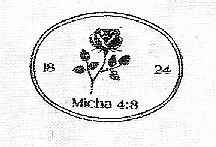 |
 |
 |
 |
|
33
|
|
|
widespread interest in alchemy, which was not simply a search for metallurgical transmutations like that of lead into gold, but a comprehensive union of practical and spiritual aims expressed in written and illustrated form through complex veiled symbols and arcane language.
As I have discussed in my book The Esoteric Origins of the American Renaissance, all of these forms of European esotericism were brought by colonists to North America in the century or more prior to the arrival of the Harmonists. Hence it is not surprising that the Rapp circleemerging out of a society in which Christian theosophy, Rosicrucianism, Freemasony, and alchemy all had had profound impactsshould have brought with it to the United States precisely these esoteric traditions. It is possible, in retrospect, to ty to separate each of these esoteric streams as though they were completely discrete from one another, but in reality for the Rapps, all of these were forged together into a single perspective that inspired their Harmonic utopian efforts in Pennsylvania and Indiana, and that undoubtedly have as their impetus a pansophic spirituality of late eighteenth century Germany closely akin to the Rosicrucian utopian dreams of early seventeenth century Europe.
It is no coincidence that the Harmonists had as their logo a golden rose, a symbol that Rapp undoubtedly recognized as joining together the various esoteric currents that had given birth to his community. The golden rose implied the alchemical transmutation of lead into gold, which could be given a spiritual interpretation as individual illumination, and a physical interpretation as referring to the rapid, almost miraculous transformation of wilderness in Pennsylvania and Indiana into ordered villages where all the inhabitants held possessions in common like the first disciples of Christ. |
|
|
|
|
 |
 |
 |
|
34
|
|
|
Additionally, the golden rose recalled the European orders of the Rosy Cross, but in some sense was a reproach to them as well in that here, in America, the Harmonists had instituted a living Rosicrucian utopia, what Rapp himself called the "destiny of man." And, of course, the golden rose recalled the theosophic expectation of the millennial reign of Christ upon earth, which the Harmonists saw themselves as inaugurating.
The place of Freemasonry in the Harmonist worldview is not quite as easy to determine as that of Böhmenist theosophy or the more distant influence of Rosicrucianism. That the Rapps were familiar with Freemasonry from European tradition is certain. One of the books in the Economy library was Leben und Thaten des Joseph Balsamo, sogenannten Grafen Cagliostro, Nebst einigen Nachrichten über die Beschaffenheit und den Zustand der Freymauerersekten (Frankenshal, 1791), a book on the life and deeds of Joseph Balsamo, also called the Count Cagliostro, as well as some remarks on Freemasonry. But the presence of books like this is not nearly so telling as the fact that in 1855, some time after the death of George Rapp, his successors gave everyone in the community a copy of a small book entitled Hirten-Brief an die wahren und ächten Freymäurer alten Systems., [Pastoral Letter to True and Genuine Freemasons of the Ancient System], with the epigraph "Wer Ohren hat, zu hören, der höre!" ("Who has ears to hear, let him hear")accompanied by an image of the grail, dated 5785, (first edition, 1781; this edition, W. Neeb, Pittsburg, Pa, 1855).
To read the Hirten-brief, click here.
At first glance, it would seem strange that the Harmonists would consider an apparently Freemasonic work like this as so central to their own beliefs, but closer analysis of the Hirten-Brief reveals it to be essentially a Böhmenist summary, full of distinctly theosophic |
|
|
|
|
 |
 |
 |
|
36
|
|
|
Here the Harmonists celebrated their various festivals, including the February 15 celebration of the Society's founding, as well as the Agape, or Love-Offering. If one looks closely in this hall, one will find two small doors, one on each end, both fairly high above those inside, for which no one can now find any use. It is entirely possible that these small doors were used in theatrical aspects of these celebrations, corresponding in some respects to Masonic initiation rites, but this is only speculative.
Although I have emphasized the influences of Böhmean theosophy, Rosicrucianism, Freemasonry, and alchemy on George Rapp and the Harmonists, and am certain that these are indeed the primary European currents feeding into this extraordinary American movement, the Harmonists were a nexus point for other major European esoteric currents as well, including magic. In the Economy library, and in private homes as well, was Das sechste and Siebente Buch Mosis, das ist: Mosis magische Geisterkunst, das Geheimnis aller Geheimnisse, (NY: Wm. Radde & Son, n.d., stamped, John House, Canton, Mo. 14th edition[!]. The Economy library also has a second edition, with advertisement for a 1737 book in back, entitled Die Magie bei den Israeliten, n.p., n.d. The book is a well-soiled copy, missing title pages, but consisting in the two books of Moses, an ink inscription "Oeconomy" on the inside of the cover. The Sixth and Seventh Books of Moses are, of course, the well-known manuals of folk magic that are so pervasive in Pennsylvania German folklore, and it is more than likely that folk magic also had its part in the Harmonist tradition.
Absolutely certain, on the other hand, is that alchemy played an important role in the lives of George Rapp and the other Harmonists. It may be hard to believe, but as I have discussed |
|
|
|
|
 |
 |
 |
|
37
|
|
|
in The Esoteric Origins of the American Renaissance, there were more than a few American settlers who engaged in very serious alchemical research while living in rather primitive and sometimes dangerous conditions on the American frontier in the eighteenth century. Seen in this context, the Harmonist preoccupation with alchemical research is not at all idiosyncratic, but part of a much more widespread interest among many in colonial and later America, including a number of major figures in prior theosophic communities on the Wissahickon River near Philadelphia and at Ephrata, Pennsylvania, as I have detailed in Wisdom's Children (SUNY: 1999). The fiction of Nathaniel Hawthorne in the mid-nineteenth century concerning alchemists does reflect the interests of actual historical figures a century or less earlier.
There are two primary authors in the Economy library whose work certainly would have been of use in alchemical experimentation. One is Paracelsus, whose Opera (Strasburg: 1603) was in Rapp's library, and whose immense influence in German esotericism can hardly be underestimated. Another such author of even greater importance for Rapp was Georg von Welling, whose book Opus Mago-Cabbalisticum et Theosophicum, (Franckfurt, 1760) is still in the Economy library, signed by George Rapp and marked "Iptingen." Rapp's copy of the Opus Mago-Cabbalisticum shows numerous marks in the margins, as well as a handwritten sheet of alchemical symbols most likely in Rapp's own hand. There are marginal marks near discussions of such topics as "the beginning and ending of all things," "fiery water," "virginal earth," "the fire of the Lord enkindled," and a long discourse on "holy things." Von Welling's book is an interesting admixture of Christian theosophy and practical alchemy combined with Christian Cabala - precisely the kind of syncretic esotericism practiced by George Rapp.
To read excerpts from the first English translation of Georg von Welling's Opus Mago-Cabalisticum, click here.
|
|
|
|
|
 |
 |
 |
|
38
|
|
|
George Rapp himself was deeply engaged in laboratory work, particularly during the Harmony Society's years at Economy, but Rapp did not do this work in isolation. Some alchemical glassware is preserved at Economy, not all of it from the laboratory of Rapp himself:

|
|
|
|
|
Alchemical notations found by the author in George Rapp's own copy of von Welling's Opus Mago-Cabalisticum at Old Economy, Pennsylvania. This is the first publication of this discovery.
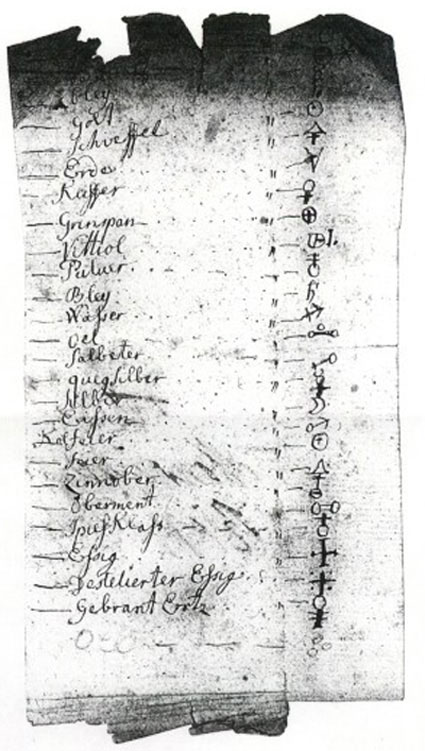 |
 |
 |
 |
|
39
|
|
|
Frederick Rapp also practiced alchemy, as did a number of others both inside and outside the Harmonist community itself. On 10 April, 1823, an old friend of Rapp's, A.F. Belser, wrote Rapp and alluded to an exclusive society of alchemical adepts that occasionally inducted those who were qualified into its ranks.[12] Later, in 1827, Belser again corresponded with Rapp, who by this time was engaged in alchemical research that was to become extremely controversial within the Harmony Society.
Here, of course, we refer to the series of events associating George Rapp with a young woman, born 1806, named Hildegard Mutschler. Before we briefly recount these events, we should note that there is a longstanding alchemical tradition a male alchemist having a young, presumably virginal woman, as an apprentice in gathering and working with alchemical substances. Such a practice is exactly what George Rapp himself engaged in, particularly during the years at Economy. Mutschler was a strikingly beautiful young woman, and had an excellent knowledge of botany. Rapp, who at this time was seventy years old, worked with her often, and she spent a great deal of time with him. Naturally, this relationship began to cause gossip, all the more so because when Mutschler became interested in a young man named Jacob Klein, Rapp sent him away from the community and paid him only $100 for his nine years of labor. When Klein protested, Rapp evidently sent him another $500.[13]
This affair came to a head in 2 September, 1829, when Frederick Rapp at midnight wrote George Rapp a long and disconsolate letter about how Rapp had been misled by Mutschler, thinking her to be a pure assistant when all the while she was in fact so full of earthly inclinations that any alchemical operation they might be undertaking |
|
|
|
|
 |
 |
 |
|
40
|
|
|
would surely fail because the heavenly Sophia would not approach or guide with such an individual present.[14] What's worse, Frederick wrote, she "always knew a way of lying to you," and had supplanted Frederick himself in George's confidences. Hildegard had run off with a young man named Conrad Feucht, and Frederick Rapp essentially was telling George "good riddance." But the Feuchts married, and nonetheless not only eventually came back to the society, they were allowed in! In the meantime, Frederick remarked that he had been so disillusioned by this affair that he himself had given up alchemical practices that formerly had been among his favorite occupations.
Now there is one more telling incident in the history of the Harmony Society, and that is the arrival of the so-called "Count Leon" and his followers. These events followed shortly after the Hildegard Mutschler saga, and could not have happened unless there were already the foundations of dissent among the Harmonists. On the 24th of September, 1829, only a couple of weeks after Frederick Rapp had written his midnight letter to George Rapp, there arrived at Economy a large and beautifully sealed impressive letter with a seal of intricate Biblical symbolism, the letter announcing the imminent arrival of the Lion of Judah. The letter had been written by one Dr. Johann Georg Goentgen, chief librarian of Frankfurt, Germany, on behalf of the Lion of Judah, "Count of Leon," the "Archduke Maximilian von Este," who saw the North American Harmonist colony as the refuge against the Beast in the end times, to which he would take his followers, the true Philadelphians.
Naturally, this letter caused a great stir among the Harmonists, who composed a reply welcoming the Count to America, and who certainly saw this event as a prophetic sign of the Harmonists' own significance in the drama of the millennium's arrival. In 1831, the |
|
|
|
|
 |
 |
 |
|
41
|
|
|
Count and Dr. Goentgen indeed arrived, and were welcomed by the Harmonists. What the Harmonists did not know, of course, is the prior history of the "Count," whose real name was Bernhard Müller, and who, having become convinced that he was the Messiah, then under the name of "Proli" had also convinced a number of wealthy nobles and members of a secret society in Germany to the same effect, thereby coming into his fortune. "Proli" had sent similar lettes to all the leaders of Europe, telling them to abdicate and let him ascend to the throne. Now, under a new name, he had arrived among the Harmonists.
By the end of 1831, the honeymoon was over so far as the Rapps were concerned: Frederick presented the Count and Goentgen with a bill for $1817.36 for their stay at the Economy tavern and store purchases. In January, 1832, the Count, having perceived the discontent among some Harmonists, presented Frederick with a declaration saying that the Count was legally and religiously one with the Harmonists and could not be presented with a bill. What is worse for the Rapps, roughly a third of the Harmonists turned out to side with the Count, insisting that Rapp's "teachings and his behavior contradict fully the word and law of God."[15] In the meantime, the Count presented Frederick with a bill for his journey to Economy at their invitation, the bill being for $15, 944.38. That did it. Frederick Rapp tried legally to eject Leon from Economy, but it was not until March that the two sides reached an agreement, according to which the dissenters would be paid $105,000 and would leave Economy with the Count and Goentgen.
During this same time, word of the "Count's" true situation back in Europe had reached Frederick, in particular the fact that the Count |
|
|
|
|
 |
 |
 |
|
42
|
|
|
did not really have money of his own. But the Count and his followers settled in Beaver County in a new city that they later named Löwenburg [Lioncity], and called themselves the New Philadelphian Congregation. Part of Count Leon's appeal was his professed association with European secret societies and his knowledge of alchemy. Even at Economy he had immediately begun having an alchemical laboratory built, which he took with him to Löwenburg. The Count also claimed that he had the philosopher's stone, but would not produce it.[16]
Eventually, the Count and his remaining followers left Pennyslvania under threat of legal action by the Rapps, and made their way to Louisiana, where the Count died in 1834. One can only imagine how profound a disappointment the "Messiah's" death was to someone as genuinely learned and of a high station as Dr. Goentgen, who had given up his position as chief librarian to follow the Count into the backwoods of America. But those in the Count's community in Louisiana went on to become fairly prosperous there, while others went on to found still another communal society in Bethel, Missouri.[17] In all of these one can see the recurring pattern, which is the emergence in America of a figure from Europe who can capture followers' imaginations with esoteric references and worldview, but whose esotericism gradually dissipates and disappears over the generations.
This is, of course, the pattern that we see in the Harmony Society itself. More than one astute observer recognized the apparent absence of a profound religious center among the Harmonists. David von Schweinitz, great-grandson of Count Zinzendorf, visited Economy in 1831, and wrote that "Only one thing struck me: judging from all he [George Rapp] let fall, there appeared to exist absolutely no real, religious foundation of the association, still less a |
|
|
|
|
The dining room of George Rapp in the great house, Economy, Pennsylvania.
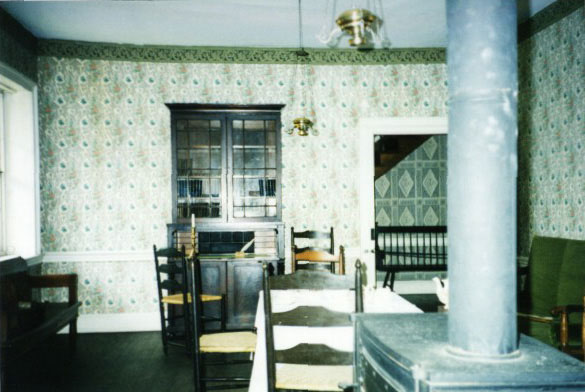 |
 |
 |
 |
|
43
|
|
|
Christian purpose, but all tended only to the bene esse." [18] This may seem a startling remark, given how prominent a role these various esoteric traditions, including very intense Christian theosophic spirituality, have obviously played in the history of the Harmony Society. But in fact it is the case that although the inspiration and motivation for the Harmony Society emerged from Western esoteric sources, the sheer material wealth of the society soon completely overpowered and suffocated what had brought the society into being.
Nothing illustrates this more than the Harmony Society's ignominious death, painfully detailed in Arndt's George Rapp's Successors and Material Heirs (1971). By 1892, a young newcomer to the Society had inveigled his way into its aging inner circle, wrested financial control from them, and by 1902, was busy vaunting himself across America as a great composer and conductor with his own orchestra. This newcomer, John S. Duss, was widely mocked in newspapers and editorial cartoons as "owner of Economy, Pennsylvania," and a millionaire conductor whose orchestra was best at making "noise."[19] Millionaire buffoon he was, made most wealthy by having sold the entire 3,000 acres of Economy farmland, village, and harbor to the American Bridge Company in 1902 and subsequently purchasing land in Florida to which, oral tradition has it, he shipped as many as eighteen traincar loads of Economy books, manuscripts, and artifacts. Within several decades, the soot in pastoral Economy, now renamed "Ambridge," was so thick that it covered the cobbled streets to a depth of nearly two feet, and Chinese workers filled warren-like buildings as the great factories clanged and clattered, only later to be abandoned. The American utopian dream of the Harmonists definitively had become an industrial nightmare. There is no record of Duss or his wife having any interest in esoterica. |
|
|
|
|
The Ambridge factory at the site of Economy - to the left are the buildings that housed Chinese workers.
 |
 |
 |
 |
|
44
|
|
|
Annotated Bibliography
No scholarly work on the Harmony Society can avoid acknowledging a debt to Karl Arndt, whose lifetime of research has preserved and made available a vast array of documentation in a series of painstakingly edited primary materials. The following books by Arndt are essential for any scholar in this area.
Arndt, Karl, George Rapp's Harmony Society (1785-1847), (Rutherford: Associated UP, 1972) revised edition [GRHS]
_____, George Rapp's Successors and Material Heirs (1847-1916), (Rutherford: Associated UP, 1971) [GRSMH]
_____, ed., George Rapp's Separatists (1700-1803), (Worcester: Harmony Society Press, 1980) [GRS]
_____, ed., Harmony on the Connoquenessing (1803-1815), (Worcester: Harmony Society Press, 1980) [HOC]
_____, ed., A Documentary History of the Indiana Decade of the Harmony Society (Worcester: Harmony Society Press, 1978) [DHID]
_____, ed., Harmony on the Wabash In Transition (1824-1826) (Worcester: Harmony Society Press, 1982) [HWT]
_____, ed., Economy on the Ohio, (1826-1834), (Worcester: Harmony Society Press, 1984) [EO]
_____, ed., George Rapp's Years of Glory (1834-1847), (New York: Peter Lang, 1987) [GRYG]
The mass of documentation compiled by Arndt here is remarkable, but only a tiny portion of it has to do with esotericism; most has to do with economic or legal correspondence. |
|
|
|
|
 |
 |
 |
|
45
|
|
|
There are two general histories of the Harmony Society that, after Arndt's definitive volumes listed above, may be of use to some scholars. One is
Hilda Kring, The Harmonists: A Folk-Cultural Approach, (Metuchen: Scarecrow Press, 1973), which includes a selection of translated Harmonist hymns to Sophia.
Another is Christiana Knoedler, The Harmony Society: A 19th-Century American Utopia, (New York: Vantage, 1954), a somewhat adulatory general look at the Harmony Society.
Among the nineteenth century scholarship useful today is Aaron Williams's The Harmony Society, (Pittsburg: W. S. Haven, 1866), inasmuch as Williams includes documentation not found elsewhere.
Mention must be made here of the self-serving account of John S. Duss, entitled The Harmonists, (Harrisburg: 1943), which can only be read in light of the actual history related by Arndt, above.
The following works may be of interest to those seeking to follow up the esoteric references in this article.
Faivre, Antoine, Jacob Needleman, eds., Modern Esoteric Spirituality, (New York: Crossroad, 1992)
Faivre, Antoine, Rolf Zimmermann, eds., Epochen der Naturmystik, (Berlin: Erich Schmidt, 1979)
Faivre, Antoine, Access to Western Esotericism, (SUNY: 1993)
_____, Philosophie de la Nature: Physique sacrée et théosophie XVIII-XIX siècle (Paris: Albin Michel, 1996)
Gibbons, B.J., Gender in Mystical and Occult Thought: Behmenism and Its Development in England, (Cambridge UP: 1996)
Hanegraaff, Wouter, New Age Religion and Western Culture: Esotericism in the Mirror of Secular Thought, (SUNY: 1998) |
|
|
|
|
 |
 |
 |
|
46
|
|
|
_____, "A Woman Alone: The Beatification of Friederike Hauffe Née Wanner (1801-1829)," in Ann-Marie Korte, ed. Women, Stories, Miracles, (New York/Leiden: Brill, 1999)
Merkur, Dan, Gnosis: An Esoteric Tradition, (SUNY: 1993)
van den Broek, Roelof, and Wouter Hanegraaff, eds., Gnosis and Hermeticism from Antiquity to Modern Times, (SUNY: 1998)
Versluis, Arthur, The Esoteric Origins of the American Renaissance, forthcoming
_____, Gnosis and Literature, (Grail: 1996)
_____, Theosophia: Hidden Dimensions of Christianity, (Lindisfarne: 1994)
_____, Wisdom's Children: A Christian Esoteric Tradition, (SUNY: 1999)
Weeks, Andrew, Boehme: An Intellectual Biography, (SUNY: 1991)
_____, Paracelsus: Speculative Theory and the Crisis of the Early Reformation, (SUNY: 1997)
Yates, Frances, The Rosicrucian Enlightenment, (London: Routledge, 1972)
Notes
1 See the list of Arndt's edited volumes in the bibliography, as well as the annotations regarding other sources, some of which are less helpful than others.
2 Arndt, Karl, ed., George Rapp's Separatists (1700-1803), (Worcester: Harmony Society Press, 1980) [hereafter GRS] 67 ff.
3 GRS 84
4 GRS 175
|
|
|
|
|
 |
 |
 |
|
47
|
|
|
5 GRS 246.
6 GRS 260.
7 See the article by Wouter Hanegraaff for an insightful overview and analysis of the case of the seeress of Prevorst: "A Woman Alone: The Beatification of Friederike Hauffe née Wanner (1801-1829)," in Anne-Marie Korte, ed., Women, Stories, Miracles, (New York/Leiden: Brill, 1999).
8 Arndt, Karl, ed., A Documentary History of the Indiana Decade of the Harmony Society (Worcester: Harmony Society Press, 1978) 440-441
9 For a selection of theosophic writings, including those of Thomas Bromley, Jane Leade, and John Pordage, as well as many others, see Arthur Versluis, ed., Wisdom's Book: The Sophia Anthology, forthcoming
10 See, on this point and for a general introduction to theosophy, Arthur Versluis, Theosophia: Hidden Dimensions of Christianity, (Hudson: Lindisfarne, 1994) as well as, for a much more in-depth examination, Wisdom's Children: A Christian Esoteric Tradition, (Albany: SUNY, 1999).
11 GRS 96-97.
12 Arndt, Karl, ed., Economy on the Ohio, (1826-1834), (Worcester: Harmony Society Press, 1984) 142
13 Arndt, Karl, George Rapp's Harmony Society (1785-1847), (Rutherford: Associated UP, 1972) revised edition, [hereafter GRHS] 425.
14 GRHS 429-433
15 GRHS 475
16 GRHS 532
17 GRHS 540
18 GRHS 447
19 Arndt, Karl, George Rapp's Successors and Material Heirs (1847-1916), (Rutherford: Associated UP, 1971) 289-317 |
|
|
|
|
|
